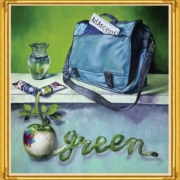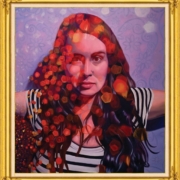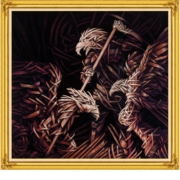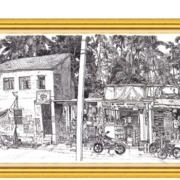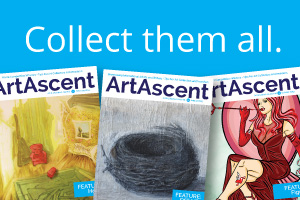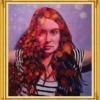Framing the masters: Behind the scenes of frame restoration and curation
It is early morning in Amsterdam’s Rijksmuseum. In a few hours, the corridors of this national gallery will be filled with thousands of visitors who flock daily to witness the works of Rembrandt, Vermeer and Van Gogh, among others. But, for now, the museum is empty, but for two people who carefully lift a painting — ‘Landscape with Rocks and a Waterfall’ by Gustav Courbet, 1872 — down from the wall.
They work quietly and carefully. It is not a sinister scene, but more of a Cinderella story. It is Hubert Baija, senior conservator of frames and gilding at the museum, and an intern from the University of Amsterdam. They have come to see whether a frame in their possession fits the painting.
“We suspected it was the painting’s original frame,” Baija says. “And not only did it fit, but we also saw that a strip of paint on the inside of the frame matched an old damage on the painting. So we knew the painting had been framed in this very frame before it was fully dry.”
Baija, 61, is tall and angular, calm in demeanor and very softly spoken, but the gleam in his blue eyes as he recounts this incident reveals what a thrilling discovery it was. “It was very exciting,” he says.
Getting the frame right, according to Baija, is an essential part of experiencing a painting authentically. “A frame can tell you many things about a painting,” he says. “Among them, when it was created, where and for what purpose.”
Appreciation for frames is relatively recent in the art world. “There was a period up until about 50 years ago when the frame was simply what the painting came in,” Baija says. “But now the frames are art pieces in their own right, and acquiring a new frame is just as exciting as acquiring a new painting, and all the better if you can reunite a frame with its original painting.”
His work demands that he be part art historian, part scientist, part artist, part matchmaker. “With framing, we try always to display paintings in their original frame,” he explains. “And we have many paintings in the museum that we know are together with their original frame.”
With works from the Middle Ages, Baija explains, it’s more likely to find an original frame with its painting. It’s in the later periods—starting in the 17th century—that it becomes more problematic. “Until then, paintings were mostly religious works, and would not trade owners and be reframed,” he says.
Changing owners and framing styles make it far more challenging to find paintings in their original frames. “When we can’t, we try to find a frame from the same period and geographical location as the painting,” Baija says. “If we can’t do that, sometimes we commission a new frame to be made.”
Baija came to be passionate about art and frames in particular in a rather indirect manner. “I wanted to be a geologist from a young age,” he says. “I was fascinated by dinosaurs. I spent hours preparing fossils, labeling and naming them. And in fact a lot of that work actually trained me for my current profession.”
He is a lecturer, author and speaker of six languages, and studied chemistry and physics before beginning a successful career as a painter and illustrator. “In the end,” he says, “art won.” For 25 years, he has worked with restoration projects at Holland’s national museum, including consulting with curators specifically about frames.
Some of his work can be done with the naked eye, if you know what to look for. For example, two paintings by Cornelis Engebrechtsz hang side by side in the Rijksmuseum: to the right, ‘Christ’s Second Visit to the House of Mary and Martha’ (c. 1520) is still in its original frame; to the left, ‘Christ Taking Leave of His Mother,’ is not.
“You can see this because the painting on the right no longer exactly fits,” Baija says, indicating that the painted wooden panel is now slightly narrower than the frame due to shrinkage over time. “The other painting fits perfectly, so we know it’s a newer frame.”
Other times, he says, initial appearances are deceiving, as is the case with Lucas van Leyden’s triptych, ‘Worship of the Golden Calf’ (c. 1530). The frame is made of oak and covered in black ebony. Its condition is perfect.
“At first everyone thought this must not be an original frame,” Baija says. “But we had dendrochronology [dating an object by using the characteristic patterns of annual growth rings in timber] performed on the wood and indeed the tree was felled as little as seventy years after the painting. This meant that we have a very valuable early reframing of Van Leyden’s work.”
Such realizations are very satisfying, he says. “It’s a mystery to solve, and it is really a great feeling to make this kind of discovery.”
The Ateliergebouw—the conservation lab of the Rijksmuseum—is where Baija spends most of his time. From the outside, the building—which faces the museum—is unassuming, but inside is a vast, six-level space with two towers. It is filled with lab equipment, studios and workshops, and underground storage areas with a passageway to the Rijksmuseum across the street.
After passing through strict security—you can only visit the Ateliergebouw by appointment—you enter into a clinically bright, quiet corridor that is like a medical facility for art. It’s hospital white and temperature controlled, with labs full of surgical microscopes and lamps. In the paper restoration area is a small incubator that would not be out of place in a premature baby ward.
The silence is one of reverence and concentration, but is occasionally broken by an excited whisper or friendly hallway encounter. Baija is truly in his element. “We have fascinating conversations in the personnel restaurant,” he says. “Everyone is working on something interesting, and making new discoveries. We are a close group.”
There is high-tech equipment for pigment analysis and imaging solutions, including a digital microscope that can produce 3D images, much like Google maps, of the topography of an object. “So you see,” Baija says, “how my early interest in geology fits in.”
What can be revealed through this relatively new technology has had a major impact on restoration knowledge. “It is really amazing,” Baija says. “We can make an X-ray based analysis at an exact point of an artwork, and see what elements it contains. In combination with other information we can deduce which materials the artist used.”
And like a forensics scientist, Baija has used technology to make new discoveries about gilding practices of hundreds of years ago. “There was an early period of Auricular framing in the Netherlands where the work wasn’t very durable,” he says. “In the same period in France you saw very delicate carving work and sophisticated gilding and texturing that held up very well over time—and in the Netherlands you couldn’t see the carving in such detail because the deteriorated frames were so often regilded.”
This, he uncovered, was because early Dutch Auricular frames were gilded using only glue as a primer, no chalk, and eventually the glue would crack and break off. It is a finding that may be hard for someone not sharing Baija’s passion for frames and art history to fully appreciate, but for Baija and his peers it is groundbreaking, and one of the reasons Baija is the most respected framing expert in Europe.
Outside of work, Baija acknowledges that sometimes it’s hard for him to give a lay explanation when someone asks him at, say, a dinner party what he does for a living, and he must fight the urge to get too technical. “Indeed,” he says. “That can happen.”
There are special labs for every walk of art—paintings, metal, glass, furniture, textiles—in which scientists in lab coats labor delicately and scrupulously. It offers a visitor a rare view of fine art, one that Baija delights in. “It is wonderful to see a tapestry from the back,” he says. “The fronts have all faded, but the backs are so colourful.”
Still the function of art restoration is not to make everything look brand new again, and like the doctors they emulate, restorers must pledge to “do no harm.” Baija says they cannot “make things back to how they originally were, because we can’t really know for sure. You can get very romantic ideas, but we do not do anything unless we are certain that we are restoring and not editing.”
Meticulous records are kept of any kind of work or treatment given to frames in the Rijksmuseum collection. “We work very diligently to record everything that we do, everything that we touch, so that people who come after us have a clear record.”
Sometimes too much historical accuracy is the wrong approach, he says. “Frames that have been gilded to look as they would have in the time the paintings were made now look too shiny, too new—the frame and the painting should look the same age.”
Other times, the choice of frame can add to the essence of a painting, even if the period is not technically correct. Such is the case, according to Baija, with ‘Willem I, Prince of Orange, also called Willem the Silent’ by Adriaen Thomasz Key, 1579. Although physically the antique frame is probably a pastiche, combining elements from different centuries, Baija thinks it is a fitting match psychologically. “He has such a tight expression, and the frame has these sorts of bolts on it, keeping the viewer at even more of a distance. It works very well.”
Baija is an encyclopedia of frame history, but his relationship to the frames is also quite personal. As a restorer, he has had the opportunity to work on many pieces, including restoring a gilded section of ‘Saint Francis Receiving the Stigmata,’ Lorenzo Monaco, c. 1420. Baija is pleased with his work, but deeply privileged by the opportunity. “To do something like that,” he says, “is really amazing. Truly wonderful.”
And he finds wonder in far more subtle contributions. While dusting “The Massacre of the Innocents,” [Cornelis Cornelisz van Haarlem, 1590] one morning,” he says, “I saw the tiny handprint of a child on the bottom rail of the frame. And that is something really poetic.”
For twenty-five years, Baija has been a protector of the Rijksmuseum’s rich collection, and it’s work he takes very seriously. Concern for art—for preserving these historical expressions of humanity—is inherent in mankind, he says. “Even at the onset of World War II, fine art was a priority—the Rembrandts were all rolled up and hidden away in 1939.”
The strict security measures in the Ateliergebouw and the rigid research and careful labour of restorers like Baija speak to the collection’s worth. “The value of what we have here is far greater than money. You cannot say, for example, ‘Okay, I guess we will have to buy another Milk Maid by Vermeer.’ No. We have to take care of it.”
By Tracy Brown Hamilton
Tracy Brown Hamilton is a freelance journalist based in Amsterdam, the Netherlands. Her work has appeared in the Atlantic, Salon, The Irish Times and Time Out Amsterdam, among other publications.

